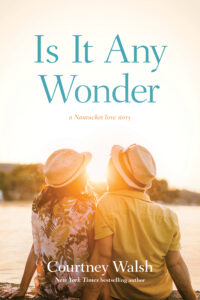By Courtney Walsh, @courtney_walsh

My love of story started in a somewhat unconventional place—on the stage. Sure, I loved reading books, but if I’m honest, they didn’t compare to the visual medium of theatre—that captured my heart when I was a little girl and it’s still holding onto it even now.
It’s interesting to think of all the ways a degree in theatre has strengthened my writing. As an actor, I learned to bring a character to life, to dig into their back story, to figure out what motivates them. And as a playwright, I learned to scale back every unnecessary piece of a story and focus only on what was being said (and what went unsaid.)
And now, character development and dialogue are my favorite aspects of writing.
Dialogue, specifically, is the most fun part of any manuscript, and I think it’s because I grew up dissecting plays and studying the art of making the words on the page feel real. When you’re playing a role in a play, that’s your job. The words and the emotion behind the words have to feel authentic or the audience won’t believe you.
It’s no different in novels. If the dialogue doesn’t sound authentic, the reader won’t buy into it. So, how do you make sure the words your character says enhance the story and not detract from it?
I won’t lie to you and tell you it’s easy. I really believe it’s a skill, but I also believe it’s one you can learn.
Here are five ways to start:
1. Consider the character. It’s important that your characters are well-defined, and that means they shouldn’t all sound the same when they talk. Dialogue is a great way to differentiate, say a hero from a heroine, or an older man from a younger one. It’s critical to get in the mind of the character and ask yourself “would he/she say this?” and “how would he/she say this?” One of the easiest ways to pull a romance reader out of a story is to write a man that sounds like a woman. Dialogue has to come from the character. Their dialect. Their slang. Their speech patterns. From there, you can begin to create characters that feel real.
*Note: Get a little perspective from someone else. For instance, I can’t even count the number of times I’ve set a scene for my husband and said “How would a guy say this?” And it’s almost never how I think.

2. Eavesdrop. I know this isn’t polite, but pay attention to conversations. I listen to the ways people talk to each other all the time. In the line at the grocery store. Sitting in the stands at a track meet. It’s less about what they’re saying and more about how they’re saying it. This is a great way to understand the speech patterns of people who don’t think or converse like we do. And who knows? You might get a great story idea in the process!
3. Read the scene out loud. This is perhaps the single best tool for creating realistic dialogue. I grew up in the theatre and currently work in theatre, so for me, talking to myself is pretty normal. I grew up practicing monologues to the wall at speech competitions—in public! So, sitting at my computer and acting out a scene is pretty normal for me. You might feel silly the first few times you do it, but you’re more likely to hear if something doesn’t work. If you trip over your words or something jumps out as awkward, change it.
4. Don’t try to sound like a writer. Writing novels is about connecting with your audience—not about showing how smart you are. I’m not saying you should dumb-down your prose, but when it comes to dialogue, if it sounds forced or overworked, it will not sound genuine. In real life, dialogue is more back and forth, so giving your characters huge monologues could come across as a little overwritten. This works on stage because the actor can bring it to life, but in a book, it’s less likely to work. When a character has a long story to tell, consider breaking it up with a paraphrased section or a bit more back and forth between characters. When we’re actually talking to each other, we interject along the way—it should be no different in your novels.
5. Read a play or twelve. There’s a difference between a play and a musical. A play, or a “straight show” has no music, whereas a musical has characters bursting into song in the middle of a scene. As you can imagine, plays are often more rooted in realism in that respect, so the dialogue is critical. And while some bits of action can be conveyed in the stage directions, the playwright is mostly relying on the spoken word to convey their point, so every word matters. They don’t include lines that don’t further the plot. And it has to be logical. Conversational. Well motivated. Novelists at every level will benefit immensely from studying how a play is written.
Dialogue is a great tool to enhance your novel. Sometimes, fast-drafting a scene using only dialogue can give you great momentum in discovering your characters and what’s happening under the surface. And if you can make your dialogue stronger, clearer and more realistic, you’ll improve your novel instantly.
How much attention do you pay to your dialogue and what’s your greatest challenge in using it to bring your characters to life?

Twelve years ago, Cody Boggs and Louisa Chambers made a pact that no matter where their lives took them, they’d return to Nantucket Island’s Brant Point Lighthouse on July 30, their shared golden birthday, and continue their tradition of exchanging birthday wishes. But that was before a tragic accident upended both of their lives, irrevocably pulling them apart.
Their worlds collide just months before that particular day when Louisa’s fledgling event planning company is hired by the local Coast Guard station, where she discovers Cody has recently returned to the island as the second in command. As they plan a regatta fundraiser, hoping to promote positive PR in the community, neither can deny the fireworks each encounter ignites. But working together also brings up memories of the day Cody’s father died, revealing secrets that have Cody and Louisa questioning everything they thought they knew and felt about their families and each other.

Courtney Walsh is a New York Times and USA Today best-selling author. She writes small town romance and romantic women’s fiction while juggling the performing arts studio and youth theatre she owns and runs with her husband. Courtney is a Carol award winner and Christy Award finalist who has written thirteen novels, two craft books and several full-length musicals. She lives in Illinois with her husband and three children and a sometimes naughty Bernedoodle named Luna.